Raptor Flight impressive on, or off, firm ground
By John Gilbert
It’s a special time of the year when late September rolls into Duluth, Minnesota, because tourists, visitors and all manner of folks drive up on the mini-mountain above the East End and follow the gravel road about a mile to its peak, which is called Hawk Ridge. It is there, when the weather and wind is right, that thousands of migrating hawks of all species fly along that ridge in breathtaking numbers.
The phenomenon is that all of the hawks and other raptors are smart enough to not want to be caught over Lake Superior, so they fly to the Westernmost tip of the big lake, then they turn south and migrate to warmer areas, sometimes as far as the Gulf of Mexico. From mid-August until the end of November, the hawks start out with the smallest accipiters and gain in size to the biggest red tails and eagles. The DNR and Audubon Society are stationed there, and have a banding station, while hundreds of spectators bring their binoculars, cameras and folding chairs to view exhibits and gaze out over the blue water, hoping to spot a big raptor.
It is also the perfect time of year to road-test a Ford Raptor — the biggest bird in the species of Ford F150 pickup trucks. The F150 remains the top-selling vehicle in the country, while the Ram is making an unprecedented bid to catch up, and the new General Motors twins of Chevy Silverado and GMC Sierra try to rebound, with new competition from Toyota and Honda.
But hot as that competition is, if one big pickup can fly up as the most capable, it would have to be the Ford Raptor.
The Raptor is more than just a tarted up F150. It is an over-the-top attempt to modify the popular F150 into the most serious off-roader in the market. When one pulls up behind you, in whatever you’re driving, a glance in the rear-view mirror shows a large, blacked-out grille, with huge letters spelling out “F-O-R-D” — unique refresher course exclusive to Raptor. If it seems much wider — like the old movie days when normal screens were replaced by wall-to-wall Cinemascope.
The striping and graphics are neat, and the test-vehicle’s Velocity Blue paint job made those graphics a bit more subtle, but the appearance is broadened — literally — by a full-size pickup that goes beyond full-size by its sheer width. Naturally it gives you more interior room, but it also gives you cornering stability as well as amazing stability for the most serious, rock-climbing adventures you can think of.
You climb up on the light, plastic running board to hop inside, before realizing they are rugged plastic-coated cast aluminum, and sit in the blue-suede Recaro bucket seats, which hold you, cocoon-like, in place for swerves, dips, unscheduled hops into thin air, and whatever challenges you can come up with, on-road or off.
To get to the capabilities, we start with the 3.5-liter V6 EcoBoost engine, worth 450 horsepower and 510 foot-pounds of torque in Raptor trim, with a 10-speed transmission. The length goes from 220 to 231.9 inches, and the width is stretched to 86.3 inches. Height is a mere 78.5 inches, so when you see it against other full-size trucks, it looks low and sleek.
Underneath, the Raptor is equipped so you could, I’m convinced, hop in the amazingly widened Raptor, switch the control button to whatever suits you best, and drive to the Arctic Circle — without setting a wheel down on a road.
It has a special frame, special suspension, unique shock-absorbers, the special high-output engine, a beefed-up transmission, and a fantastic interior to set it all off. For all it has, it costs you, of course, with a base price of $55,840, and adds $17,520 in options. It wasn’t all that long ago that you could buy a pickup truck for $17,520, and now that’s just the tab for the options — sending the total sticker price to $74,955.
OK, nobody who is sane will recommend you should buy a $75,000 pickup truck, but if you have the budget for it, my recommendation is don’t take one for a test-drive unless you have your checkbook with you.
With all that power, it will go 0-60 in a mere 5.2 seconds, and while its EPA fuel estimates are 15 miles per gallon city and 18 highway, we found both of those reachable, clocking mostly 16-17 mpg in city driving and occasionally getting it up to 20-22 on freeway trips.
Driving in Minnesota this summer means that if you don’t get the chance to go off-roading, negotiating the pothole-filled Duluth streets, or doing the orange-barrel slalom from Duluth to Minneapolis, can at least approximate the need for an off-road vehicle.
The exterior’s headlights include a neat outline of LEDs, night and day, with distinctly sharp LED headlights and foglights, and those little lights atop the cab that resemble those that adorn heavy-duty work trucks.
But when you put it all together, go foraging where the off-road rock-climbers like to play, and you learn immediately that the suspension is in another world. When Ford was building this version of the Raptor, it went to Fox, the competition shock and suspension experts, and worked with them to perfect and install Fox Live-Valve, electronic-control shocks that are so high-tech they can go from soft to stiff in 40 milliseconds.
When you’re bouncing along over rocky terrain, if the computer senses that you are airborne, the shocks use their oil-flow insides to stiffen, so that when you come down from wherever it is you are airborne, the Raptor won’t bottom out as you crash to Earth, the way softer shocks would.
Think about that. These shocks, unique to the Raptor, are so advanced they can sense miniscule alterations in your venture and adjust almost as if anticipating what’s going to happen.
You also can set the Trail control for crawl speed. People who are either sane, or haven’t ventured into serious off-roading, may not be aware of how important it is to be able to crawl slowly up and over the biggest boulders, or ruts or ridges, and then keep your speed in check when you descend. The computer-activated Fox Shocks in the Raptor will crawl up, over, and down, so you can focus on steering and missing the largest and most treacherous chunks and boulders.
To me, though, the most impressive thing is how the Raptor behaves when you come off the trail, out of the wilderness or mountains, and get the Raptor out on the highway or on city streets, where behavior is necessary. Driving on Duluth’s Swiss-cheese-like streets and suburban roadways, you would accept and forgive the Raptor if it jolted and jarred your bones, because it is so firm off the road, you anticipate harshness and rigidity on the road. Yet the Raptor suspension is surprisingly compliant on the road, and it seems to almost float over the corrugated roads.
I might be wrong, but I found the Raptor was smoother-riding and more comfortable than the standard, garden-variety F150, or other full-size pickup competitors. If that’s all because of the Fox shocks, then we all should have them.
Ford knows its got a winner on its hands, but I think it is guilty of under-promoting the on-road sophistication of the Raptor. It might encourage a flow of truck-fanatics who would be willing to spend a lot of money for such a cool truck that also works as a family truckster. Consider the creature features: automatic on-off high beams, power tailgate lock, trailer sway control, fold-up rear bench seat, dynamic hitch assist, electric shift-on-the-fly 4×4, pre-collision warning and assist, reverse sensing and rear view cameras, skid plates, terrain management system, perimeter alarm, power sliding rear window, 360-degree camera, trailer back-up assist, voice-activated navigation and an excellent Bang and Olufsen sound system.
Going to the Raptor option list, the high-output 3.5 EcoBoost engine, technology package, tailgate step, bedliner and wheels and graphics are added. The connectivity stuff is all there, too.
You have this Trail control knob that can be set for whatever terrain you are engaging, including gravel, sand, snow, normal roadways…whatever. We never got it out of rear-wheel drive, alas, during our brief week treating it like our everyday vehicle. I would love to have it for another week in the most blizzard-filled week of Duluth winter to try out the other switches.
I felt I had accomplished something when I made it through the narrowed freeway lanes without conking an orange barrel or two, and I felt even more in command when I drove into a parking ramp that required a couple of sharp corners. As I pulled in, my wife, Joan, let out a bit of a shriek because she was sure I had scraped the ceiling of the ramp entrance, and when I circulated up a level, we heard the scraping again.
Turns out, it was the little antenna poking up and touching the roof of the ramp. Ford thinks of everything — even a curb-feeler for your roof.
Without a doubt, the pickup battles will continue to rage, and the specialty versions that command top dollar from every manufacturer can bring in more profit. But the Raptor is the rare specialty truck that blends its on-road smoothness to make it no-contest for absolute king of the road.


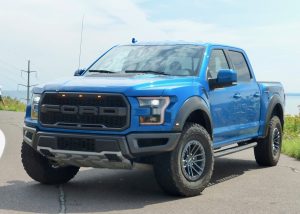
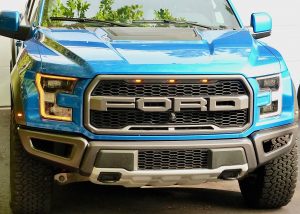
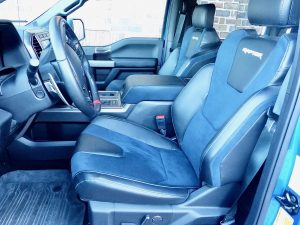
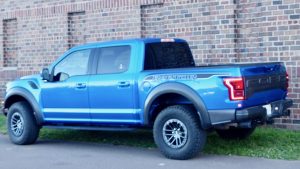
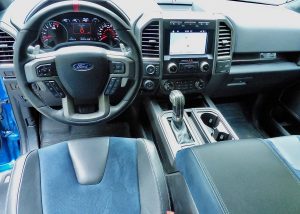

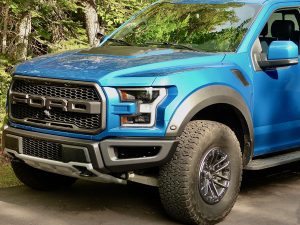
 John Gilbert is a lifetime Minnesotan and career journalist, specializing in cars and sports during and since spending 30 years at the Minneapolis Tribune, now the Star Tribune. More recently, he has continued translating the high-tech world of autos and sharing his passionate insights as a freelance writer/photographer/broadcaster. A member of the prestigious North American Car and Truck of the Year jury since 1993. John can be heard Monday-Friday from 9-11am on 610 KDAL(www.kdal610.com) on the "John Gilbert Show," and writes a column in the Duluth Reader.
John Gilbert is a lifetime Minnesotan and career journalist, specializing in cars and sports during and since spending 30 years at the Minneapolis Tribune, now the Star Tribune. More recently, he has continued translating the high-tech world of autos and sharing his passionate insights as a freelance writer/photographer/broadcaster. A member of the prestigious North American Car and Truck of the Year jury since 1993. John can be heard Monday-Friday from 9-11am on 610 KDAL(www.kdal610.com) on the "John Gilbert Show," and writes a column in the Duluth Reader.